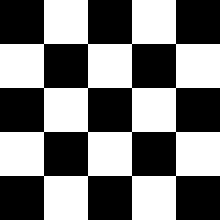Moran's I
In statistics, Moran's I is a measure of spatial autocorrelation developed by Patrick Alfred Pierce Moran.[1][2] Spatial autocorrelation is characterized by a correlation in a signal among nearby locations in space. Spatial autocorrelation is more complex than one-dimensional autocorrelation because spatial correlation is multi-dimensional (i.e. 2 or 3 dimensions of space) and multi-directional.

Definition
Moran's I is defined as
where is the number of spatial units indexed by and ; is the variable of interest; is the mean of ; is a matrix of spatial weights with zeroes on the diagonal (i.e., ); and is the sum of all .
Defining weights matrices
The value of can depend quite a bit on the assumptions built into the spatial weights matrix . The idea is to construct a matrix that accurately reflects your assumptions about the particular spatial phenomenon in question. A common approach is to give a weight of 1 if two zones are neighbors, and 0 otherwise, though the definition of 'neighbors' can vary. Another common approach might be to give a weight of 1 to nearest neighbors, 0 otherwise. An alternative is to use a distance decay function for assigning weights. Sometimes the length of a shared edge is used for assigning different weights to neighbors. The selection of spatial weights matrix should be guided by theory about the phenomenon in question.
Expected value
The expected value of Moran's I under the null hypothesis of no spatial autocorrelation is
At large sample sizes (i.e., as N approaches infinity), the expected value approaches zero.
Its variance equals
where
Values of I usually range from −1 to +1. Values significantly below -1/(N-1) indicate negative spatial autocorrelation and values significantly above -1/(N-1) indicate positive spatial autocorrelation. For statistical hypothesis testing, Moran's I values can be transformed to z-scores.
Moran's I is inversely related to Geary's C, but it is not identical. Moran's I is a measure of global spatial autocorrelation, while Geary's C is more sensitive to local spatial autocorrelation.
Uses
Moran's I is widely used in the fields of geography and geographic information science. Some examples include:
- The analysis of geographic differences in health variables.[4]
- It has been used to characterize the impact of lithium concentrations in public water on mental health.[5]
- It has also recently been used in dialectology to measure the significance of regional language variation.[6]
- It has been used to define an objective function for meaningful terrain segmentation for geomorphological studies[7]
Sources
- Moran, P. A. P. (1950). "Notes on Continuous Stochastic Phenomena". Biometrika. 37 (1): 17–23. doi:10.2307/2332142. JSTOR 2332142.
- Li, Hongfei; Calder, Catherine A.; Cressie, Noel (2007). "Beyond Moran's I: Testing for Spatial Dependence Based on the Spatial Autoregressive Model". Geographical Analysis. 39 (4): 357–375. doi:10.1111/j.1538-4632.2007.00708.x.
- Cliff and Ord (1981), Spatial Processes, London
- Getis, Arthur (3 Sep 2010). "The Analysis of Spatial Association by Use of Distance Statistics". Geographical Analysis. 24 (3): 189–206. doi:10.1111/j.1538-4632.1992.tb00261.x.
- Helbich, M; Leitner, M; Kapusta, ND (2012). "Geospatial examination of lithium in drinking water and suicide mortality". Int J Health Geogr. 11 (1): 19. doi:10.1186/1476-072X-11-19. PMC 3441892. PMID 22695110.
- Grieve, Jack (2011). "A regional analysis of contraction rate in written Standard American English". International Journal of Corpus Linguistics. 16 (4): 514–546. doi:10.1075/ijcl.16.4.04gri.
- Alvioli, M.; Marchesini, I.; Reichenbach, P.; Rossi, M.; Ardizzone, F.; Fiorucci, F.; Guzzetti, F. (2016). "Automatic delineation of geomorphological slope units with r.slopeunits v1.0 and their optimization for landslide susceptibility modeling". Geoscientific Model Development. 9: 3975–3991. doi:10.5194/gmd-9-3975-2016.